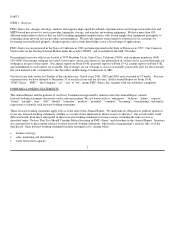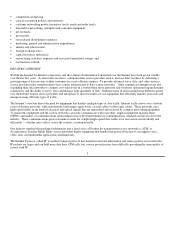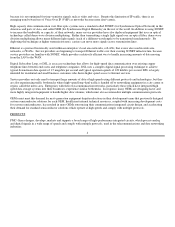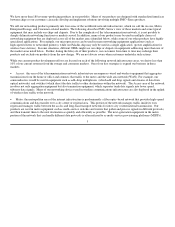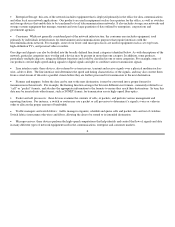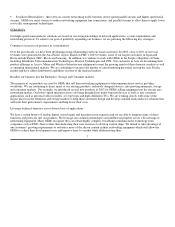Adaptec 2003 Annual Report Download - page 15
Download and view the complete annual report
Please find page 15 of the 2003 Adaptec annual report below. You can navigate through the pages in the report by either clicking on the pages listed below, or by using the keyword search tool below to find specific information within the annual report.
quantity and the shipment schedules to reflect changes in their needs. We believe orders placed for delivery in excess of six months
are not firm orders. As of December 31, 2003, our backlog of products scheduled for shipment within six months totaled $63.5
million. Unless our customers cancel or defer to a subsequent year a portion of this backlog, we expect this entire backlog to be filled
in 2004. Our backlog of products as of December 31, 2002 for shipment within six months totaled $41.0 million.
Our backlog includes our backlog of shipments to direct customers, minor distributors and a portion of shipments by our major
distributor to end customers. Our customers may cancel, or defer to a future period, a significant portion of the backlog at their
discretion without penalty. Accordingly, we believe that our backlog at any given time is not a meaningful indicator of future
long−term revenues.
COMPETITION
We typically face competition at the design stage when our networking customers determine which communications semiconductor
components to use in their next generation equipment designs.
Most of our customers choose a particular semiconductor component primarily based on whether the component:
• meets the functional requirements;
• addresses the required protocols;
• interfaces easily with other components in a design;
• meets power usage requirements;
• is priced competitively; and
• is brought to market on a timely basis.
OEMs are becoming more price conscious than in the past as a result of the downturn in the telecommunications industry, and as
semiconductors sourced from third party suppliers comprise a greater portion of the total materials cost in OEM equipment. We have
also experienced aggressive price competition from our competitors. These circumstances may make some of our products less
competitive, and we may be forced to decrease our prices significantly to win a design.
In addition to price, OEMs will also consider the quality of the supplier when determining which component to include in a design.
Many of our customers will consider the breadth and depth of the supplier’s technology, as using one supplier for a broad range of
technologies can often simplify and accelerate the design of next generation equipment. OEMs will also consider a supplier’s design
execution reputation, as many OEMs design their next generation equipment concurrently with the component design. OEM’s also
consider whether a supplier has been pre−qualified, as this ensures that components made by that supplier will meet the OEM’s
quality standards.
Our competitors may be classified into two major groups. First, we compete against established peer−group semiconductor
companies that focus on the communications semiconductor business. These companies include Agere Systems, Applied Micro
Circuits
11



